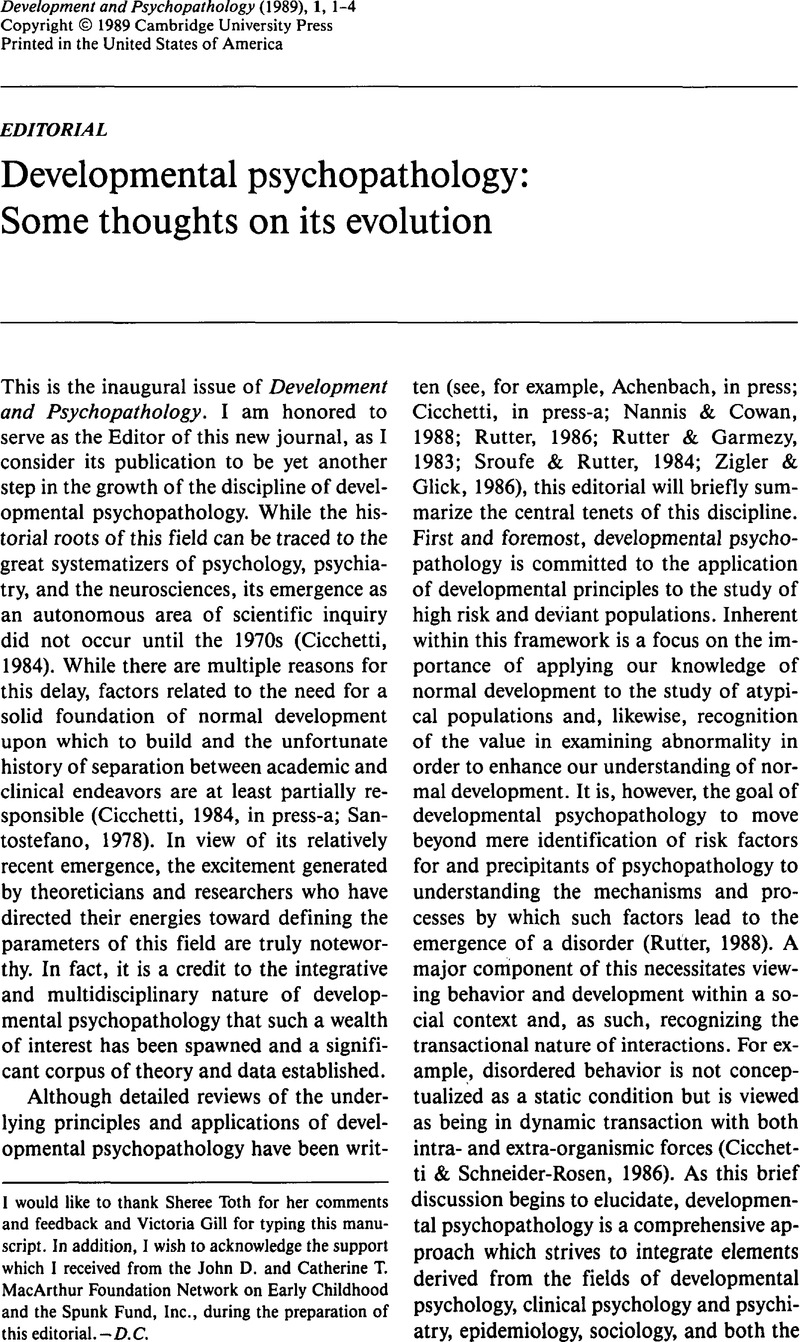Crossref Citations
This article has been cited by the following publications. This list is generated based on data provided by Crossref.
Ketterlinus, Robert D.
Bookstein, Fred L.
Sampson, Paul D.
and
Lamb, Michael E.
1989.
Partial least squares analysis in developmental psychopathology.
Development and Psychopathology,
Vol. 1,
Issue. 4,
p.
351.
Dilalla, Lisabeth Fisher
and
Gottesman, Irving I.
1989.
Heterogeneity of causes for delinquency and criminality: Lifespan perspectives.
Development and Psychopathology,
Vol. 1,
Issue. 4,
p.
339.
Cowen, Emory L.
Wyman, Peter A.
Work, William C.
and
Parker, Gayle R.
1990.
The Rochester Child Resilience Project: Overview and summary of first year findings.
Development and Psychopathology,
Vol. 2,
Issue. 2,
p.
193.
Parker, Gayle R.
Cowen, Emory L.
Work, William C.
and
Wyman, Peter A.
1990.
Test correlates of stress resilience among urban school children.
The Journal of Primary Prevention,
Vol. 11,
Issue. 1,
p.
19.
Stattin, Håkan
and
Klackenberg-Larsson, Ingrid
1990.
The relationship between maternal attributes in the early life of the child and the child's future criminal behavior.
Development and Psychopathology,
Vol. 2,
Issue. 2,
p.
99.
Alessandri, Steven M.
1991.
Play and social behavior in maltreated preschoolers.
Development and Psychopathology,
Vol. 3,
Issue. 2,
p.
191.
Alessandri, Steven M.
1991.
Play and social behavior in maltreated preschoolers.
Development and Psychopathology,
Vol. 3,
Issue. 2,
p.
191.
Reznick, J. Steven
Hegeman, Irene M.
Kaufman, Emily R.
Woods, Scott W.
and
Jacobs, Marlene
1992.
Retrospective and concurrent self-report of behavioral inhibition and their relation to adult mental health.
Development and Psychopathology,
Vol. 4,
Issue. 2,
p.
301.
Hohagen, Fritz
1992.
Zwangsstörungen / Obsessive-Compulsive Disorders.
p.
57.
Richers, John E.
and
Cicchetti, Dante
1993.
Mark Twain meets DSM-III-R: Conduct disorder, development, and the concept of harmful dysfunction.
Development and Psychopathology,
Vol. 5,
Issue. 1-2,
p.
5.
Richters, John E.
and
Martinez, Pedro E.
1993.
Violent communities, family choices, and children's chances: An algorithm for improving the odds.
Development and Psychopathology,
Vol. 5,
Issue. 4,
p.
609.
Fonagy, Peter
Steele, Miriam
Steele, Howard
Higgitt, Anna
and
Target, Mary
1994.
The Emanuel Miller Memorial Lecture 1992 The Theory and Practice of Resilience.
Journal of Child Psychology and Psychiatry,
Vol. 35,
Issue. 2,
p.
231.
Cowen, Emory L.
Wyman, Peter A.
Work, William C.
and
Iker, Miriam R.
1995.
A preventive intervention for enhancing resilience among highly stressed urban children.
The Journal of Primary Prevention,
Vol. 15,
Issue. 3,
p.
247.
Heller, Tracy L.
Baker, Bruce L.
Henker, Barbara
and
Hinshaw, Stephen P.
1996.
Externalizing behavior and cognitive functioning from preschool to first grade: Stability and predictors.
Journal of Clinical Child Psychology,
Vol. 25,
Issue. 4,
p.
376.
STILWELL, BARBARA M.
GALVIN, MATTHEW
KOPTA, STEPHEN MARK
and
PADGETT, ROBERT J.
1996.
Moral Valuation: A Third Domain of Conscience Functioning.
Journal of the American Academy of Child & Adolescent Psychiatry,
Vol. 35,
Issue. 2,
p.
230.
HOAGWOOD, KIMBERLY
JENSEN, PETER S.
PETTI, THEODORE
and
BURNS, BARBARA J.
1996.
Outcomes of Mental Health Care for Children and Adolescents: I. A Comprehensive Conceptual Model.
Journal of the American Academy of Child & Adolescent Psychiatry,
Vol. 35,
Issue. 8,
p.
1055.
PIKE, ALISON
and
PLOMIN, ROBERT
1996.
Importance of Nonshared Environmental Factors for Childhood and Adolescent Psychopathology.
Journal of the American Academy of Child & Adolescent Psychiatry,
Vol. 35,
Issue. 5,
p.
560.
Prins, P. J. M.
de Wit, C. A. M.
and
Goudena, P. P.
1997.
Angst in ontwikkelingspsychopathologisch perspectief.
Kind en adolescent,
Vol. 18,
Issue. 4,
p.
127.
Cowen, Emory L.
and
Wyman, Peter A.
1998.
Resilience in children: the nature and the importance of the concept.
Psicologia Escolar e Educacional,
Vol. 2,
Issue. 3,
p.
247.
Ollendick, Thomas H.
and
Vasey, Michael W.
1999.
Developmental Theory and the Practice of Clinical Child Psychology.
Journal of Clinical Child Psychology,
Vol. 28,
Issue. 4,
p.
457.


